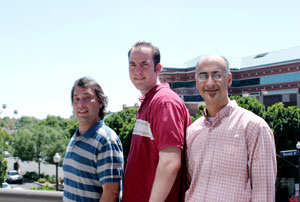
Computers and commuters: A high-tech approach to reducing traffic congestion

The minds behind WITA (left to right) Robert Flasher, Charles Dairman and Hessam Sarjoughian. (Photo by Jessica Slater)
Living in a region undergoing rapid population growth can be stressful, especially when it comes to traffic.
In the Phoenix metropolitan area, the urban and suburban expansion that comes with population growth means more traffic congestion and longer commuting times for many drivers.
More time driving in congested traffic also means more wear and tear on automobiles because of frequent braking and acceleration, and increased fuel emissions that worsen air quality.
Hessam Sarjoughian, a professor in the Department of Computer Science and Engineering in the Ira A. Fulton School of Engineering, is working on solutions to the growing traffic problem using his expertise in computer-based modeling and simulation and software engineering.
He has devised an internet-based software tool to integrate regional traffic and weather information — information already available from sources such as the Arizona Department of Transportation and the National Weather Service — allowing users get a comprehensive look at the situation on the streets before getting into a car.
“If people begin to make better transportation choices, like waiting to leave work until a roadway accident has cleared, it can significantly affect the entire transportation system,” says Sarjoughian.
Avoiding or preventing traffic congestion is not the only benefit of making informed choices about when and where to drive. By spending less time in traffic, people can have more time to work or spend with their families.
Sarjoughian began his project in 2004 by pitching the idea to students in his Introduction to Software Engineering class, asking them to build on the software concept he had envisioned, called WITA — Weather Information and Traffic Assistant.
Nine groups of undergraduate students worked to integrate traffic and weather data for several cities, including Phoenix, San Diego and Chicago. Some groups added features such as weather data analysis, live video feed of road segments and simulations of traffic flow.
With support from the National Science Foundation, the Fulton Undergraduate Research Initiative (FURI) and the Department of Computer Science and Engineering, one team, led by students Robert Flasher and Charles Dairman, continued to develop WITA at the Arizona Center for Integrative Modeling and Simulation at Arizona State University. Sarjoughian is co-director of the center, which is jointly administered by the University of Arizona.
Today, WITA can be accessed through the center’s website at http://wita.asu.edu . It provides users with specific information on traffic accidents and roadway construction from the state transportation department and is updated every 15 minutes and displayed graphically on interactive maps powered by Google. Weather information is provided by the National Weather Service and includes a weekly weather forecast, information on air quality, a Doppler radar and ski-conditions report.
Using WITA, a connection to the internet is all that’s needed to help make informed decisions such as when to leave for the airport, or which routes to take to a show playing downtown. But the software can be used to do much more, says Sarjoughian. Like many software tools, it offers a larger-picture functionality.
Sarjoughian hopes the software, which is constantly gathering and storing specific sets of traffic and weather data, could eventually semi-autonomously run “what-if” simulations to analyze changes in traffic patterns and the effects on pollution levels, or provide simulated data for missing raw data.
Because the relationship between natural and engineered environments continues to grow in complexity and scale, society needs more sophisticated tools to monitor the implications of such relationships, Sarjoughian says.
“In a larger context, there is a clear understanding that the interplay between weather and traffic needs to be managed,” he says. “The eco-engineered systems pose new transdisciplinary research and development challenges in perpetuity with a mandate to not only create useful information, but to make that information readily accessible.”
Although the information provided by WITA could be gathered from a handful of different websites, the beauty of WITA is its convenience.
“Our role is to collect data and synthesize it in a form that is usable to the ordinary person,” says Sarjoughian. Integration of various sets of data is also a form of resource optimization, he explains: “It’s not just resources like fuel that are wasted. Time and productivity can be squandered, too. If information is gathered but not made available to the public in a useful way, it’s simply wasted.”
Writer: Deanna Evans



































